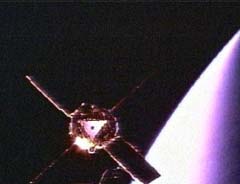Gravity Probe B status report

The Gravity Probe B spacecraft is shown in orbit around the Earth, as viewed by a camera mounted on the second stage of the Delta II rocket that carried it to space. Now placed in its polar orbit of 400 miles above Earth, the Gravity Probe B spacecraft circles the globe every 97.5 minutes, crossing over both poles. (NASA/KSC)
At 9:57:24 am Pacific Daylight Time on Tuesday, April 20, 2004, the Gravity Probe B spacecraft had a picture-perfect launch from Vandenberg Air Force Base in South-central California. The Boeing Delta II rocket hit the exact center of the bull’s eye in placing the spacecraft in its target polar orbit, 400 miles above the Earth.
“The Gravity Probe B Mission Operations Team has performed very well during this critical spacecraft activation period,” said Tony Lyons, Gravity Probe B NASA Deputy Program Manager from Marshall Space Flight Center in Huntsville, Ala.
“We’re ecstatic,” said Stanford Gravity Probe B Program Manager, Gaylord Green. “We couldn’t have asked for a better or more beautiful launch-nor a more perfect orbit insertion.”
At approximately one hour eleven minutes, the spacecraft’s solar arrays deployed, and shortly thereafter, the on-board cameras treated all viewers, via NASA TV, to the extraordinary sight of the separation of the spacecraft from the second stage rocket, with a portion of the Earth illuminated in the background.
After two days in orbit, all Gravity Probe B systems are performing as planned. The solar arrays are generating power, and all electrical systems are powered on. The spacecraft is communicating well with the Tracking and Data Relay Satellite System (TDRSS) and supporting ground stations.
All four Gyro Suspension Systems have now been activated. In addition, a lift check was successfully accomplished for gyros #2 and #3. “We’ve successfully achieved the first of many upcoming steps in preparing these four gyroscopes for science data collection,” said Rob Brumley, Stanford Gravity Probe B Deputy Program Manager, Technical. “We are all extremely gratified with the initial performance of these gyroscopes in space, including the first ever levitation of a Gravity Probe B gyro on orbit.”
The spacecraft’s Attitude Control System is maintaining initial attitude control. Fine attitude control should be achieved when thruster calibrations have been completed. After that, the ultra-precise science telescope will be locked onto the Gravity Probe B guide star, IM Pegasi, to within a range of 1/100,000th of a degree.
“All of us on the GP-B team are very grateful for the tremendous support we have received from NASA, Lockheed Martin, Boeing, and many others,” said Francis Everitt, Gravity Probe B Principal Investigator at Stanford University. “We’re off to a fine start, but we now have a great sense of responsibility to make sure we do the science in the best possible way.”
The spacecraft is being controlled from the Gravity Probe B Mission Operations Center, located at Stanford University. The Initialization & Orbit Checkout (IOC) phase of the Gravity Probe B mission is planned to last 45-60 days, after which the 12-month science data collection will begin. This will be followed by a two-month final calibration of the science instrument assembly.
NASA’s Gravity Probe B mission, also known as GP-B, will use four ultra-precise gyroscopes to test Einstein’s theory that space and time are distorted by the presence of massive objects. To accomplish this, the mission will measure two factors — how space and time are warped by the presence of the Earth, and how the Earth’s rotation drags space-time around with it.
NASA’s Marshall Space Flight Center in Huntsville, Ala., manages the Gravity Probe B program for NASA’s Office of Space Science. Stanford University in Stanford, Calif., developed and built the science experiment hardware and operates the science mission for NASA. Lockheed Martin of Palo Alto, Calif., developed and built the GP-B spacecraft.
Media Contact
More Information:
http://www1.msfc.nasa.gov/NEWSROOM/news/releases/2004/04-118.htmlAll latest news from the category: Physics and Astronomy
This area deals with the fundamental laws and building blocks of nature and how they interact, the properties and the behavior of matter, and research into space and time and their structures.
innovations-report provides in-depth reports and articles on subjects such as astrophysics, laser technologies, nuclear, quantum, particle and solid-state physics, nanotechnologies, planetary research and findings (Mars, Venus) and developments related to the Hubble Telescope.
Newest articles

First-of-its-kind study uses remote sensing to monitor plastic debris in rivers and lakes
Remote sensing creates a cost-effective solution to monitoring plastic pollution. A first-of-its-kind study from researchers at the University of Minnesota Twin Cities shows how remote sensing can help monitor and…

Laser-based artificial neuron mimics nerve cell functions at lightning speed
With a processing speed a billion times faster than nature, chip-based laser neuron could help advance AI tasks such as pattern recognition and sequence prediction. Researchers have developed a laser-based…

Optimising the processing of plastic waste
Just one look in the yellow bin reveals a colourful jumble of different types of plastic. However, the purer and more uniform plastic waste is, the easier it is to…


